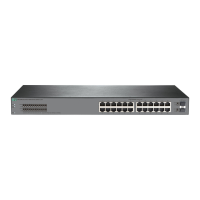69
Within a detection interval, an IRF member device can record MAC address move information for a
maximum of 20 MAC addresses. The records are ranked in descending order of MAC move counts.
When the MAC move count of a new record is higher than the MAC move count of any existing
record, the device performs the following operations:
• Discards the record that has the lowest MAC move count.
• Ranks the MAC address move records in descending order of MAC move count.
Then in the next detection interval, the device discards all MAC address move records generated in
the previous detection interval and starts another round of MAC move record generation.
After you execute this command, the system sends only syslog messages to the information center
module. If the
snmp-agent trap enable mac-address command is also executed, the
system also sends SNMP notifications to the SNMP module.
Examples
# Enable MAC address move notifications.
<Sysname> system-view
[Sysname] mac-address notification mac-move
[Sysname]
%May 14 17:16:45:688 2013 Sysname MAC/4/MAC_FLAPPING: MAC address 0000-0012-0034 in VLAN
500 has moved from port GE1/0/1 to port GE1/0/2 for 1 times
The output shows that:
• The VLAN ID of MAC address 0000-0012-0034 is VLAN 500.
• The MAC address moved from GigabitEthernet 1/0/1 to GigabitEthernet 1/0/2.
• The MAC address has moved once within a MAC move detection interval.
Related commands
display mac-address mac-move
mac-address notification mac-move suppression (interface
view)
Use mac-address notification mac-move suppression to enable MAC address move
suppression on an interface.
Use
undo mac-address notification mac-move suppression to disable MAC address
move suppression on an interface.
Syntax
mac-address notification mac-move suppression
undo mac-address notification mac-move suppression
Default
MAC address moves are not suppressed.
Views
Layer 2 Ethernet interface view
Layer 2 aggregate interface view
Predefined user roles
network-admin

